Growing up, I've eaten my share of zongzi (Mandarin 粽子, or bakchang 肉粽 in Hokkien) although my mother didn't manage to obtain any wrapping skills or our family's recipe from my grandmother. I've also only been exposed to the savory variant of the dumpling (filled with pork belly, beans, dried shrimps, salted egg yolk and a chestnut) and always assumed they all look like the triangular ones we eat in Malaysia and Singapore. A recent cooking class at Hong Kong's City Super in accordance with the Dragon Boat Festival (端午節) yesterday opened my eyes to the intriguing shapes of dumplings in Hong Kong and Taiwan.

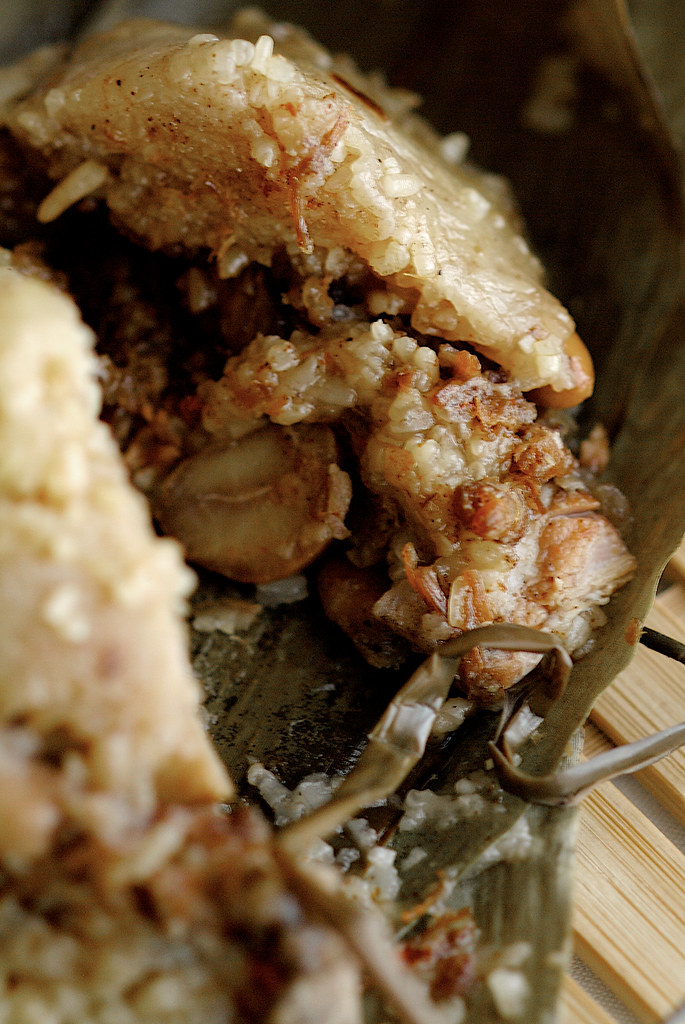
To my delight the instructor turned out to be a friendly and very knowledgeable auntie instead of a restaurant chef. Call me skeptical but I think something traditional like this would be better off learned from someone who has done it for years from family experiences and flavors rather than a commercial chef. Dorothy was very generous with her tips and tricks, all the while encouraging us to take photos and record videos for later references. We started off with the kansui zong (in Cantonese 碱水粽), the alkaline dumpling treated with aqueous sodium carbonate (alkaline water) to obtain a smooth, puffed texture and yellow in color, filled with a sweet center, typically red bean or lotus pastes.



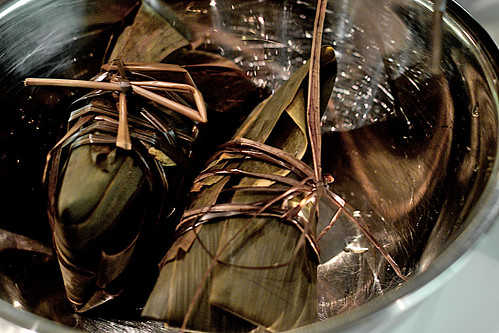

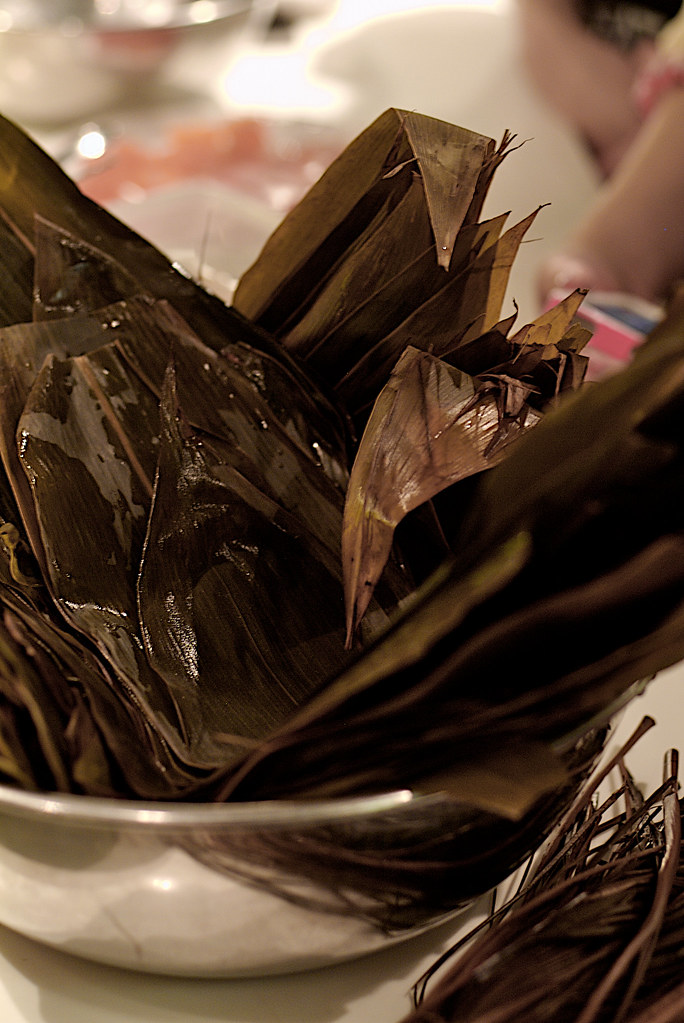
I quickly discovered that wrapping the zong itself was not difficult. The time consuming bits were the preparation of the leaves, rice and other ingredients before hand. The bamboo leaves are best soaked overnight instead of being boiled to maintain it's green color. The glutinous rice also requires at least six hours of soaking and the filling ingredients better cooked the day before for deeper flavor development. Dorothy's savory dumpling recipe included her homemade XO sauce, which kicked ass so much I promptly asked if she could share her recipe, to which she happily replied "That would be another class." Leaving Hong Kong tomorrow, I might just risk emailing her for it.
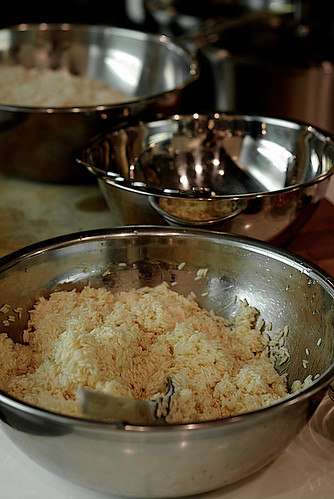
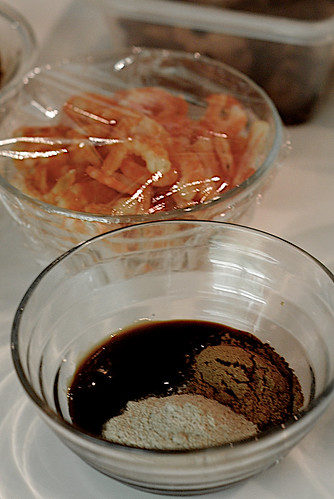
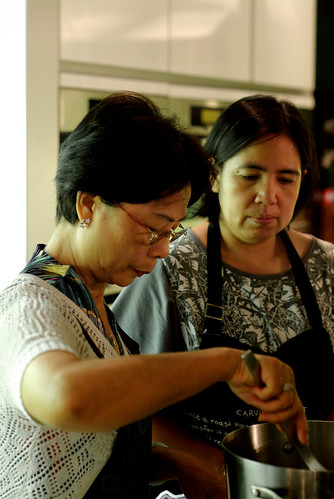
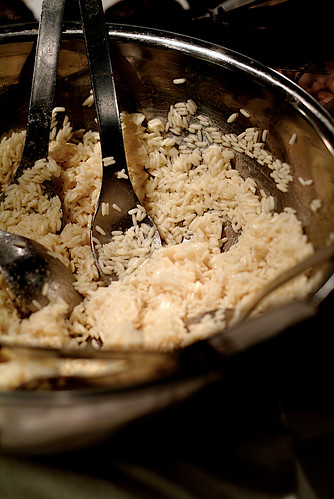
The kansui zong used two small leaves and took no time at all to wrap. Pre-shape the red bean paste filling into balls or quenelles and place loosely between a few tablespoons of rice. Make sure the wrapped zong is not tightly filled by giving it a shake after folding the leaves to seal. Dorothy's recipe used an ingredient everyone in the class asked if they could omit. Pang sa (boric acid) is a toxic chemical traditionally added when preparing the rice to prevent it from sticking to the leaves after the dumplings are cooked. Since its role is largely cosmetic in the final product, most homemade alkaline dumpling recipes do without it.
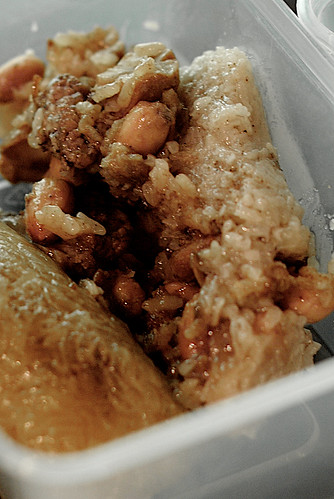

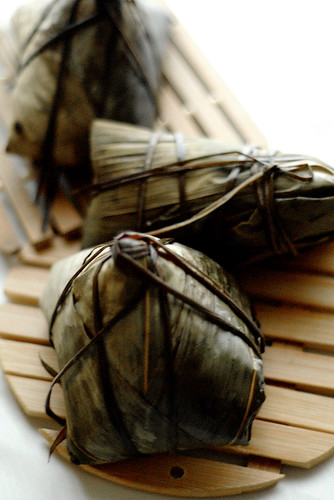
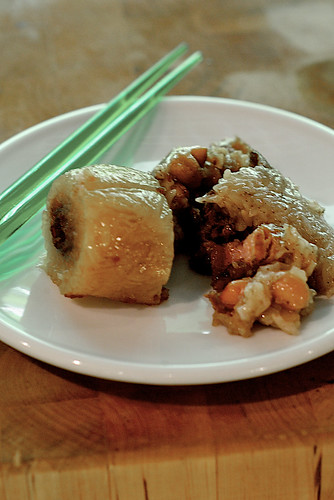
The salty pork dumpling which I would attempt to make once I get back took some maneuvering to wrap. I put as much meat and other stuffing items as I could muster into the rather smallish dumplings and you can see from the photos the results of my amateurish attempt complete with bits of uncooked rice trapped on the top. When wrapping a savory zong it's crucial to pack the filling tightly and press down while wrapping to produce a neat dumpling with evenly cooked rice. Dorothy pointed out that it's not always possible to get large leaves from the market so we will have to be flexible enough to add extra leaves and use torn leaves as well when making zong in bulk (a typical recipe makes 20 to 25 dumplings). Just make sure there are no exposed rice or filling poking out of the wrapped product before tying it up.
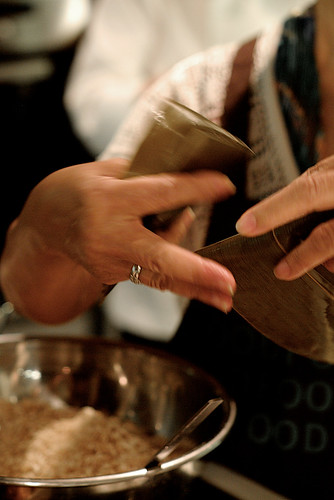
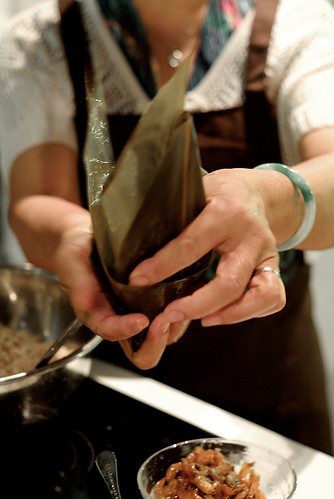

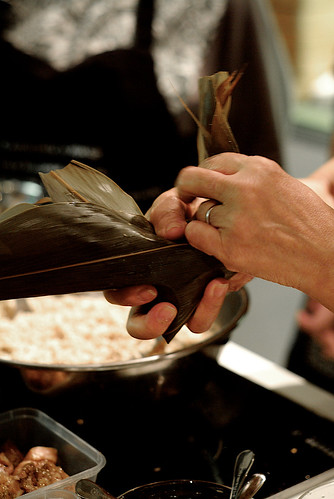

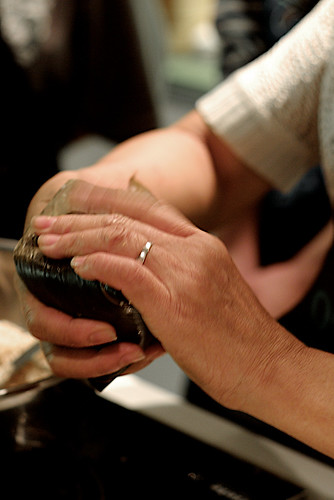
She also demonstrated a better tying method looping around the peak of the dumpling instead of just going by the sides to avoid slipping. I've never eaten dumplings with XO sauce before and loved Dorothy's version. As every family probably have their own recipes, making zongzi, like a lot of home cooking, is not about hard and fast rules. It's about love wrapped in a bundle of rice with the favorite things of you and your family. There's no need to fuss about the exact measurements and seasonings used. The traditional agak agak (roughly in Malay) approach and a little bit of patience would do to create the ultimate dumpling you would enjoy.
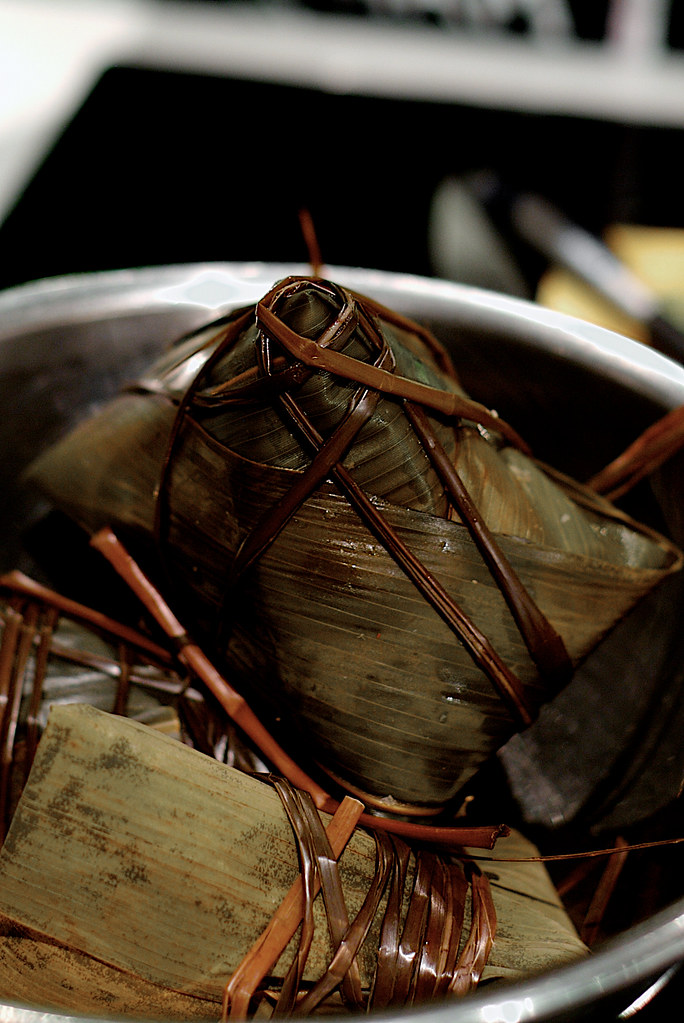
What's more important is to prepare and cook the rice to the right consistency before wrapping. In the excitement of telling us her stories in our class, Dorothy got a little carried away and misjudged just by a hair the amount of moisture required for the savory zong but even that didn't affect the dumpling much. The possibilities of filling ingredients are endless. You can make halal versions with chicken thigh, lamb or beef; healthier options with lean meat and more beans or even vegetarian ones with black-eye peas, a variety of mushrooms, nuts and mung beans. As we sampled the dumplings Dorothy made for us beforehand, I didn't care much for the sweet ones for more than a couple of reasons, I reckoned. I didn't like the idea of using alkaline water, the rice bits were largely tasteless and I just couldn't get my head around a sweet zong - it's all about what you grew up with sometimes.
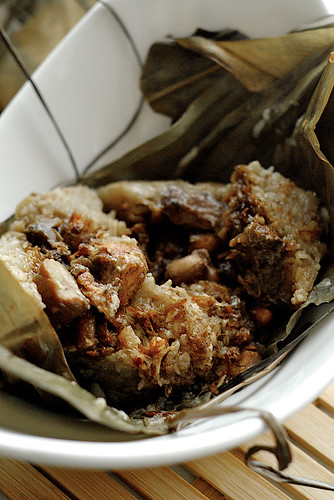
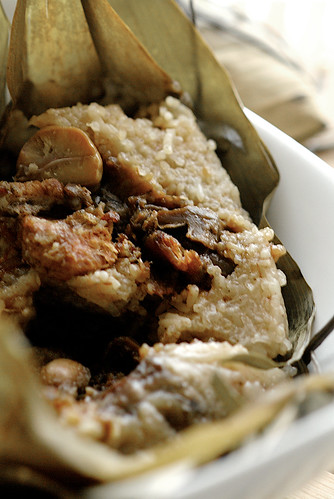
Her awesome meat dumpling though, convinced me to arrange for the procurement of bamboo leaves as soon as logistically possible in Singapore as by the time I land the markets would no longer be selling any (thanks so much Sherie!). Zongzi are available all year long in Malaysia and Singapore long after the festival, so no one really need an excuse to eat some. It's just that only during this period the bamboo leaves and grass 'strings' are easily available at neighborhood wet markets. Towards the end of the class, Dorothy provided us her contact information and reminded us to call her should we face any difficulties or have any questions when trying this stint out at home. She said that the best satisfaction for her would be for us to really take our lesson home and actually make some dumplings. Now, if you think that's cool of her, read on.
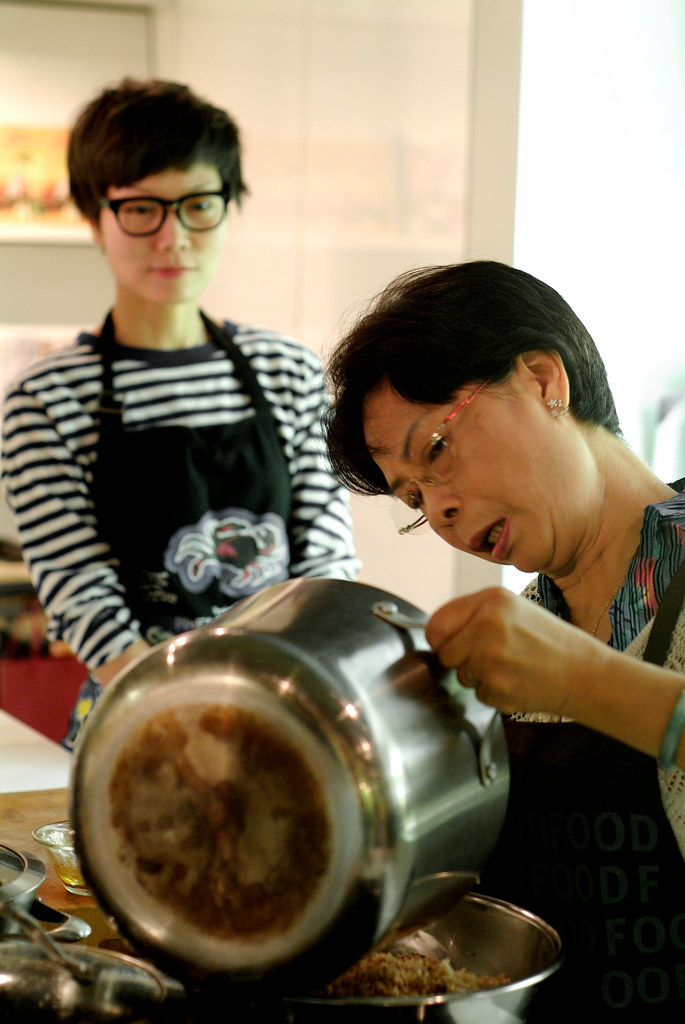
The dumplings we wrapped were to be packed up to be boiled at home. Staying in a hotel room, there was no way I could do that so I told Dorothy to take mine and have it for herself, if she didn't mind dealing with my newbie end products. I was floored when she offered to cook them for me to be collected another day, just so that I can taste the fruits of my 'labor'. Tasty dumplings aside, what I also took with me from Dorothy's class was an important reminder - cook with passion and attention to detail for best satisfaction, it will not only show through your food and but touch those who are blessed with it.

I don't know if I can pull this off but I'm definitely going to attempt wrapping some savory zong with homemade XO sauce. Should I succeed you'll hear me going on about it here and I hope your eyes won't glaze over another post on dumplings. As I'm currently still shooting with only prime lenses, I couldn't photograph the entire wrapping process clearly. The wrapping methods for both Hong Kong and Taiwanese style dumplings are here and here respectively. In the latter, notice how the grandmother eventually instructed the addition of an extra leaf to cover the apprentice's dumpling. They also began with two leaves instead of one as they were wrapping a larger savory dumpling instead of a small alkaline one.



You are very clever and able to master the wrapping so quickly. My mom has been teaching me this and todate, I still am hopeless. This year she declared that she retired from dumpling making. Guess I can only salivate on yours.
ReplyDeleteI love bak chang but don't know how to wrap. Ick. ;)
ReplyDelete
ReplyDeletePrecious Moments: Oh dear, another tradition not passed to the next generation. This is happening a lot. At least get the recipe down, the wrapping can be delegated to the rest of the family members.
Bee: You should try! The Malaysia/SG version is not hard I think. The Hong Kong one uses 4 leaves to wrap a pyramid shape. Taiwanese version easiest.
this was a lovely post. I videotaped my grandma making her zongzi (cantonese style) a few years ago as my mom and dad's generation have not picked up this tradition. i hope one day to carry it on and do a zongzi cooking demo with my non-Chinese friends here in Dubai as well.
ReplyDeleteshall we play sand together? my sis-in-laws both can wrap the dumplings, so for now I shall only need to cook fillings ..... they don't sell bammboo leaves all year round? better keep stock then. see you in 2 weeks.
ReplyDelete
ReplyDeleteginger and scotch: Which is the Cantonese style? Is it the triangular one or the pyramid one? In Dubai that would be cool, though can you find pork there?
mrs. chan: I don't think I'll wrap a lot the first time round, maybe quarter the recipe to wrap 5 or something, since no one is around to eat it! Then I'll keep some leaves for us to play sand together. Why don't you bring over some extra leaves?
i think cantonese is the same style as the one in your blog post.
ReplyDeleteyes, pork is easily attainable on Dubai - just more expensive than buying in, say, the US and some cuts aren't available.
going to the Chinese market this weekend to find some bamboo leaves. do you know of any online resources?
ginger and scotch: Oh dear.. I'm hopeless in that part of the world but have a friend staying there who's a Muslim. Let me ask her and see if she knows.
ReplyDeleteginger and scotch: quick reply from said friend asked to check out a number of chinese grocery shops at International City (China cluster). Hope this helps!
ReplyDeleteNice post and really good photos... especially step by step wrapping...
ReplyDeleteWe plan to make some this weekend... (I know 'terlepas boat')... missing out on the event itself... has been a long time since we ate this ...
Lisa: It's never too late! Just got my leaves and am making some XO sauce today to wrap some dumplings this weekend. Happy dumpling!
ReplyDelete